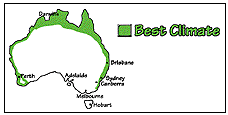
Tree Waratah
The tree waratah in flower will stop you in your tracks. It is a native tree that comes from the Queensland rainforests. It is striking in flower when it is laden with bold scarlet red waratah-like flowers. At other times it has dark green leaves.
Details
Common name: Tree waratah
Botanic name: Alloxylon flammeum. The tree has been plagued by name changes and was known previously as Oreocallis wickhamii and Embothrium wickhamii. It is from the protea family, Proteaceae, a group which also includes waratahs (Telopea speciosissima) and grevilleas.
Climate: It is grown in the tropics and subtropics and as far south as Sydney and Perth. It needs a warm or coastal position in colder zones such as Sydney as it is not frost tolerant. Our specimen was filmed in Brisbane where it flowers in mid to late spring (October) when the jacarandas are flowering. The plants occur naturally on the Atherton Tableland in wet to very wet rainforests.
Good points:
- A tree native to the rainforests of Australia which grows to about 8-10m (25-30′) tall and spreads to about 2-4m (6-12′). It may be smaller in gardens (4-8m or 12-24′) and is sometimes seen as a large shrub.
- Masses of brilliant red waratah-like flowers in spring, which resemble a waratah. These flowers attract nectar-feeding birds.
- Young plants will flower in two years in the tropics when they are grown in ideal conditions. May take longer in cooler districts.
Uses:
- A brightly coloured bird-attracting tree.
- Adds brilliant red flowers to any tropical or semi-tropical garden.
- Shade tree.
Likes:
- Full sun in a warm spot. Best flowering occurs in a spot in full sun.
- Well-watered and moist.
- Protection from wind.
Dislikes:
- Do not fertilise after planting as it is extremely sensitive to fertiliser. Once established it is possible to fertilise annually with a low phosphorus fertiliser for natives, such as Osmocote for Natives.
- Yellowing of foliage after planting may indicate an iron deficiency which can be treated with chelated iron (available at nurseries).
Getting started
Tree waratahs are not widely available, especially outside the tropics and subtropics, but are being grown by some Australian native and rainforest specialist nurseries such as Yuruga Nursery at Walkamin in Far North Queensland (this nursery does not sell to the public or offer mail-order). If not in stock, ask your garden centre or native plant nursery to order plants for you or try the following nurseries:
New South Wales
Sydney Wildflower Nursery
9 Veno Street, Heathcote, NSW, 2233
Ph: 02 9548 2818
Email: [email protected]
www.sydneywildflowernursery.com.au
Daley’s Fruit Tree Nursery
36 Daley’s Lane, Geneva via Kyogle NSW. 2474 www.daleysfruit.com.au
email: [email protected]
Queensland
Fairhill Native Nursery
114- 132 Fairhill Road
Nindery QLD
Phone: (07) 5343 7906
www.fairhill.com.au
Further reading
For more information consult Growing Australian Tropical Plants by Peter and Ann Radke and Garry and Nada Sankowsky. (Frith and Frith Books, Malanda, 1993).


